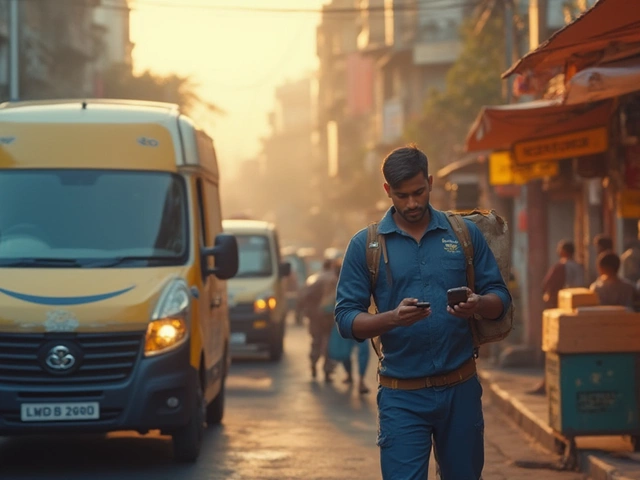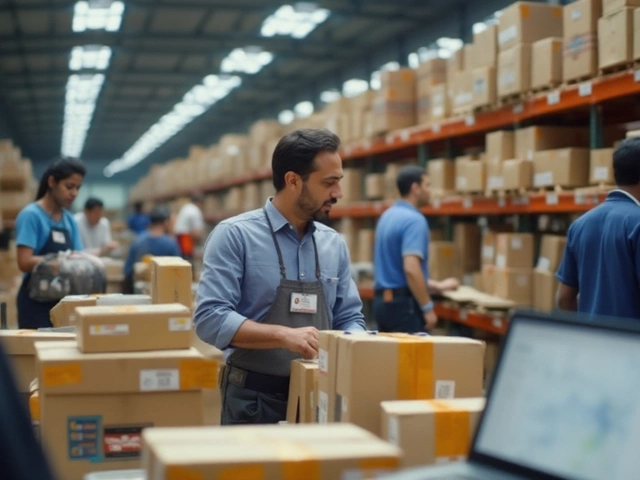When you need something delivered tomorrow, the pressure is on. It doesn’t matter if it’s a forgotten birthday present or something crucial for work—waiting is just not an option. So, which next day delivery service should you trust to actually come through?
People jump to big names like FedEx, UPS, DPD, and even Amazon Prime, hoping for speed and reliability. But not all of these services work the same way in every city or for every type of package. I’ve learned the hard way (like scrambling for a last-minute gift for Cecilia), that details like pickup cut-off times and exact delivery zones matter a lot more than glossy promises.
Choosing the right service isn’t about who has the flashiest ads or the biggest fleet. It comes down to hard facts: Are they on time, do they cover your area, and will they make you pay extra for a box that’s a couple of centimeters too large? The real trick is understanding what you’re actually getting for that next day premium.
- The Big Next Day Players: Who’s in the Game?
- Speed vs. Reliability: Which Matters More?
- Comparing Costs and Hidden Fees
- Surprising Real-World Delivery Experiences
- Tips for Beating the Delivery Clock
- When Next Day Really Isn't Next Day
The Big Next Day Players: Who’s in the Game?
When it comes to next day delivery, a handful of names keep popping up no matter where you live. Each big courier has a slightly different approach, and with shipping speeds getting faster every year, the competition is real.
Here’s a quick rundown of who’s leading the charge—and what they’re actually promising when you pay extra for fast shipping:
- FedEx Express: Practically everywhere, their Priority Overnight gives you delivery by 10:30 a.m. to many business addresses. They hit over 200 countries and handle everything from letters to 68kg packages.
- UPS Next Day Air: UPS will get a parcel to most U.S. addresses the next morning. Some places even get it by 8 a.m. They offer solid tracking and handy pickup drop-offs at their branded stores.
- DPD Next Day: Over in the UK and most of Europe, DPD’s got a reputation for one-hour delivery windows and slick tracking. They’re the typical pick for online shops needing to move stuff quick.
- Amazon Prime One-Day: Amazon delivers a huge number of their own Prime items by the next day—if you spot the “Prime” badge, odds are good you’ll get it in 24 hours or less, especially in metro areas. Not everything qualifies, so double-check before clicking.
- DHL Express: More global than local in places like the U.S., but DHL is the go-to for next day or same day deliveries especially if you’re shipping overseas. Businesses with international customers use them a lot for their speed and customs know-how.
Curious how these services stack up on paper? Look at this:
| Carrier | Cut-off Time for Drop-off | Coverage | Typical Next Day Delivery Time |
|---|---|---|---|
| FedEx Express | Up to 6:00 p.m. | USA, International | 10:30 a.m.–noon |
| UPS Next Day Air | 6:00–7:00 p.m. | USA, Limited International | 8:00 a.m.–end of day |
| DPD Next Day | Up to 7:00 p.m. | UK, Europe | By end of next working day |
| Amazon Prime | Varies (usually midnight) | Selected areas | By 8:00 p.m. next day |
| DHL Express | Usually 5:00 p.m. | Global | By end of next working day |
What really separates them is how predictable they are and how many hoops you need to jump through. Some will come straight to your door; others want you to meet them at set pickup points if you miss their window. Almost none guarantee mornings unless you pay premium, so keep an eye on those little details.
Speed vs. Reliability: Which Matters More?
Quick isn’t always best if the delivery doesn’t make it on time or lands at the wrong door. When you’re sizing up next day delivery services, you’ve got to figure out what you really need: absolute speed or a rock-solid guarantee the package will show up when promised.
Let’s talk facts. UPS claims on their own tracking stats about 96% of their Next Day Air shipments in major US cities arrive right on schedule. FedEx, not to be outdone, posts their Priority Overnight with a 97% on-time rate, but you’ve got to check their pickup cut-off—sometimes 6 PM, sometimes earlier if you live out in the sticks. Amazon Prime says next day, but they actually shrink their guarantee windows during busy times, and some zip codes are left out entirely.
| Service | Advertised On-Time Rate | Cut-off Time | Weekend Delivery |
|---|---|---|---|
| UPS Next Day Air | 96% | ~6 PM (varies) | Saturday Optional, Sunday Unavailable |
| FedEx Priority Overnight | 97% | ~6-7 PM (varies) | Saturday Optional, Sunday Unavailable |
| Amazon Prime** | 93%-98% (areas vary) | Usually late evening | Saturday & Sunday Available in Some Areas |
| DPD Next Day* | About 95% | Typically 5-7 PM | Saturday at Extra Cost |
*Based on UK/European markets. **Data gathered from reported averages, not all products or addresses qualify.
There’s another wrinkle—sometimes speed isn’t what you want most. I ordered replacement glasses for Cecilia once. I splurged for same-day. They arrived next morning, but the driver mixed up our house for the neighbors. Fast, but not helpful. A good tracking system (DPD texts you to the hour the driver will come) can beat a slightly faster service where you’re left guessing.
- If you need guaranteed arrival for something critical (medicine or documents), stick with FedEx or UPS, and check the fine print on refunds for late deliveries.
- If you’re shipping to a big city, speed is usually better. Out in the suburbs? Reliability matters more—drivers can get lost or delayed in rural routes.
- If you’re ordering from Amazon, double-check that 'next day' is really an option for your address—sometimes it quietly switches to two-day last minute.
Bottom line: Sometimes slower but steady wins. Look up real customer ratings for your specific area, not just company averages. Speed feels flashy, but reliability is what saves you from late-night headaches and angry calls.
Comparing Costs and Hidden Fees
Next day delivery sounds quick—until you get to the checkout and the total almost doubles. Nobody loves being surprised by a hidden fee, but it’s reality with most next day delivery services. The prices also keep changing based on package weight, size, or how late in the day you drop your item off. Here’s what you’re really working with when comparing the big services head-to-head.
You’ll notice starting rates look reasonable ($10 to $20 for small packages), but things pile up fast. Let’s break down a few real cost examples (as of 2025):
| Courier | Basic Next Day Rate | Extra Fees |
|---|---|---|
| FedEx | $18.50 | Fuel surcharges, oversized packages, rural surcharge |
| UPS | $16.75 | Saturday delivery, residential delivery fee |
| Amazon Prime | Free (with Prime, select items) | Limited by region and item type |
| DPD | $15.20 | Large item surcharge, address change fee |
Some of the sneakiest costs come from things like:
- Going just a hair over the weight or size limit
- Needing a delivery on a Saturday or Monday
- Address corrections after you send the package
- Remote area or apartment surcharges
I once paid $30 extra on top of a $15 delivery because my package was half a kilogram over the stated limit, and I live in a suburb (which apparently counts as a “remote area” for some couriers).
"Always read the full rate card and triple-check size restrictions before booking any next day delivery—it’s the unexpected fees that sting the most."
—Consumer Reports, 2024 Delivery Services Guide
Here’s a pro tip: Use the online price calculators most couriers post right on their websites. Plug in your actual package size, weight, pickup, and drop-off times. And always ask customer service if your address is in a surcharge zone. It can mean the difference between a decent deal and a bill that makes you swear off next day delivery for life.

Surprising Real-World Delivery Experiences
Behind the online promises and bold claims from delivery services, reality sometimes delivers a shock. Over the past year, the biggest lesson from countless next day delivery attempts is simple: almost no one’s perfect all the time. Even the top providers have hiccups, with real people and random events at the center of the mess.
Take Amazon Prime’s "guaranteed" next day delivery. During Black Friday, thousands of orders across London and Manchester got bumped to two days due to driver shortages. The app blamed "unexpected demand", but that didn't help those expecting gifts or groceries. And let’s not pretend it’s just Amazon—last December, a friend ordered vital medication via UPS Next Day Air. The parcel made it to his city overnight, then sat in the warehouse another full day because of an address typo. Customer service was fast to refund the shipping fee, but the delay nearly caused a hospital trip.
Local couriers add another twist to the story. In some areas, small businesses partner with local bike or same-day van couriers instead of bigger companies. Turns out, these folks sometimes outpace the giants! A bakery in Leeds started using a startup messenger service and now reports that 97% of their rush birthday cake deliveries show up before noon—quicker than either DHL or Royal Mail managed the year before.
Here are a few eye-openers people should keep in mind:
- Weather chaos: During the Storm Ciarán floods, DPD kept updating tracking links promising on-time delivery. The vans didn’t move for two days because of road blockages, and customers only got a vague “delayed by conditions” email.
- Unexpected wins: Some testers found FedEx Priority Overnight surprisingly reliable for rural postcodes, even outperforming Royal Mail Special Delivery in regions like Cornwall.
- Technology mess-ups: Drop-off lockers sound handy, but packages sometimes got marked “delivered” before arriving. Customers chasing their parcels for hours just for support to admit the system glitched and the package was still in the courier’s van.
The point is, next day delivery isn’t magic, even with all the tech and tracking in the world. Double-check addresses, ask for written confirmation of delivery windows, and have a backup plan if your item is really urgent. Sometimes, that little-known local courier is your safest bet.
Tips for Beating the Delivery Clock
Missing the cut-off by even ten minutes can turn your next day delivery into a two-day wait. Timing matters more than anything else. Most big couriers have a daily deadline—like 5 p.m. for UPS Next Day Air or 6:30 p.m. for FedEx Overnight. Check your local branch’s exact hours, because drop-off times can be earlier in smaller towns. Amazon Prime, for instance, usually needs you to order before noon.
Not all drop-off locations offer the same level of service. Some FedEx Office or UPS Stores can accept packages for late pick-up, especially in major cities. When in doubt, call ahead. I’ve saved a last-minute shipment before just because a helpful clerk squeezed it in past the deadline.
Here’s what you can do to boost your chances of success:
- Print your label at home and pack your box before heading out. Store lines can be nuts after work and slow you way down.
- Double-check your address—one messed up digit can send your package to the wrong city, and rerouting kills any hope of "next day."
- Pick a box size that fits the service’s rules. Oversized or odd packages can get bounced to slower (and pricier) shipping without warning.
- Track your shipment obsessively. Most services update within minutes. If you see a delay, call customer support right away—sometimes they can fix things mid-transit.
- Don’t forget holidays and weekends. Most companies don’t count Saturday and Sunday in their "next day" promise unless you pay extra. FedEx Priority Overnight does deliver on Saturdays, but only if you choose that option.
If it’s a gift or something super time-sensitive, add a note for the recipient (or stick around for delivery if you can). Sometimes a missed delivery attempt means losing a whole day, since a lot of couriers won’t try again until the next business day.
The key is to treat every next-day shipment like a mini mission. Study the process, prep ahead, and stay on top of the tracking. You’d be surprised how many delivery disasters you can dodge with just a bit of planning.
When Next Day Really Isn't Next Day
Everyone's been burned by supposed next day delivery that drags on for days (if not lost entirely). Even if the site promises it in bold letters, there are a bunch of reasons why 'next day' can turn into 'who knows when.' Knowing these common pitfalls saves you a headache and helps set realistic expectations—especially when you need something ASAP.
First, cutoff times trip up a lot of folks. For most carriers, you have to order before a specific time—often 2pm or 5pm—or your package won’t even leave until the next business day. Weekends? Good luck. Plenty of services don’t count them as delivery days. This is a huge source of disappointment, especially during holiday rushes.
- Amazon Prime Next Day isn’t always eligible for every ZIP code or item. If you’re outside major metro areas, their 2024 data showed real next day deliveries dropped to 55% in rural spots.
- FedEx and UPS both claim high reliability (over 95% on-time pre-pandemic), but in 2023, ShipMatrix tracked a dip during weather events and strikes—dropping to 78% in some regions on certain days.
- Unexpected delays: traffic, weather, and sorting errors can push that next day parcel out another 24-48 hours, no matter the courier.
Instead of getting surprised, keep an eye on these things:
- Check the actual shipping cutoff for next day service (it’s listed in the fine print).
- Avoid weekends and public holidays if timing is tight.
- Double check your postcode or ZIP; fast delivery zones aren’t universal.
- Track your shipment as soon as you get the tracking number—delays tend to show up there first.
Here’s how on-time rates looked for next day delivery in the busiest weeks of December 2024:
| Courier | Advertised On-Time % | Actual On-Time % (rural areas) | Common Delay Reasons |
|---|---|---|---|
| Amazon Prime | ~95% | 55% | Inventory, zip code gaps |
| FedEx | 98% | 82% | Weather, late pickups |
| UPS | 97% | 80% | Staff shortages, floods |
| DPD | 96% | 79% | Sorting errors |
Point is, next day means different things to different companies—and locations. Read the fine print, check those cutoff times, and always track what matters. Anything “guaranteed” can still go wrong. Having a backup plan (or at least a warning for whoever’s waiting) is sometimes the real life saver.





